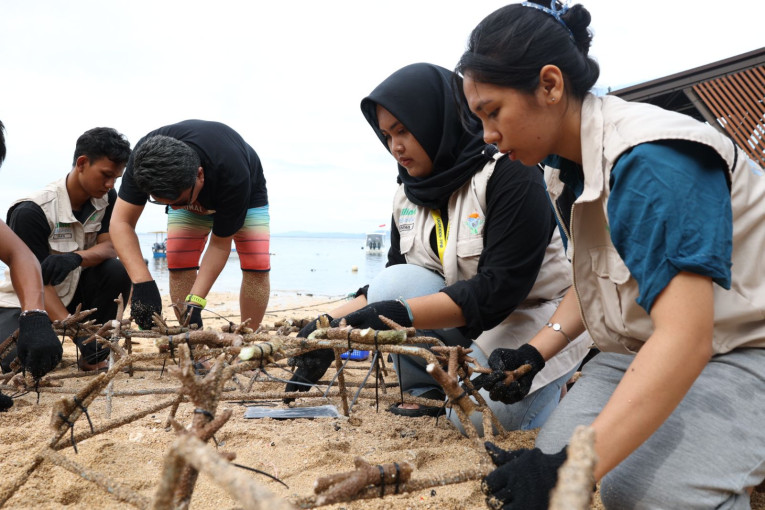
UGM KKN PPM students, in collaboration with the Bunaken National Park Authority and local communities, carried out a coral transplantation program by installing 550 transplants to restore the ecosystem affected by the construction of the Bunaken Village Ecotourism pier.
The coral transplantation installation was conducted on Bunaken Island from late June until Aug. 19 during the UGM KKN PPM activities.
Coinciding with National Conservation Day on Saturday (Aug. 10), the Head of Bunaken National Park, Faat Rudhianto, and the KKN student team symbolically installed coral transplantation media near the Bunaken pier waters.
Faat Rudhianto stated that the coral transplantation activity with UGM KKN students aimed to restore the damaged coral reefs around Bunaken Island.
“In Bunaken, about 30 percent of the coral reefs are damaged and need transplantation. So, ecosystem restoration is the last resort. Other methods involve natural succession where we only manage, supervise, and monitor the existing reefs,” said Rudhianto.
He mentioned that the coral reef area in Bunaken spans approximately 6,000 hectares, with 30 percent of the reefs needing restoration.
“Most of the damage is caused by human activities,” he explained.
One of the leading causes is destructive fishing practices, such as fish bombing and using potassium to stun fish.
The Spider method, or spider frame, was employed for the transplantation. This involves a hexagonal iron framework to which Acropora corals are attached.
Rudhianto further explained that coral transplantation is similar to planting terrestrial plants. As coral requires sunlight for photosynthesis, the maximum depth for transplantation is 10 meters.
“Acropora corals are quite resilient to natural conditions, growing 1 to 3 cm per year, and 95 percent of the ones we installed are successful,” he emphasized.
Kharisma Pundhi Rukmana, a UGM KKN PPM Agro team representative, reported that the students have installed 550 coral transplantation media in collaboration with Bunaken National Park management during their KKN activities.
Although the Bunaken National Park Authority used the spider method, Rukmana experimented with a bio-reeftek model for coral transplantation. This method uses natural materials, such as coconut shells arranged in layers with iron frames embedded in square concrete blocks.
According to Rukmana, this idea emerged during the first week of their KKN in Bunaken when he and his team observed the island and saw the abundant potential of coconut shell waste.
“Seeing this potential, we tried to work with the community to create bio-reeftek because coconut shells are easily available, and the application is straightforward,” Rukmana said.
Rukmana hopes that if this method proves successful in Bunaken, the community will be able to develop it independently due to the abundant resources.
“The mechanism will involve sinking the bio-reeftek to the seabed, which will attract new coral substrates,” Rukmana explained.
Author: Gusti Grehenson
Photographer: Firsto

